Banker on the Spot: Weathering a man-made flood
Morgan City and its hometown bank versus the Atchafalaya River
- |
- Written by Steve Cocheo

- Residents of Morgan City, part of Louisiana’s “Cajun Coast,” are no strangers to alligators. But they are usually found back in wild areas, not swimming right in the Atchafalaya River, like this fellow snapped—pardon the pun—by banker Larry Callais during the city’s recent floods. Callais says the gator was just one of many dispossessed creatures driven into populated areas by flood control measures.
Water, water everywhere. It’s usually the blessing of Morgan City, La., which sits at the juncture of the Gulf Intracoastal Waterway and the Atchafalaya River. That makes it a gateway to the Gulf of Mexico for shrimpers and the offshore oil business, as well as for recreational boating. But in May and early June, the abundance of water around Morgan City became a problem.
Opening up “The Morganza”
Facing major threats of flooding to Baton Rouge and New Orleans, La., the U.S. Army Corps of Engineers determined to open spillway gates of the Morganza Floodway control structure. The structure is part of flood control measures completed in 1954 by the Corps. The gates are designed to divert part of the Mississippi’s waters into the Atchafalaya River and the Atchafalaya Basin, the country surrounding the river.
Only once, in 1973, has the spillway ever been activated. This May, it was activated again.
Facing major threats of flooding to Baton Rouge and New Orleans, La., the U.S. Army Corps of Engineers determined to open spillway gates of the Morganza Floodway control structure. The structure is part of flood control measures completed in 1954 by the Corps. The gates are designed to divert part of the Mississippi’s waters into the Atchafalaya River and the Atchafalaya Basin, the country surrounding the river.
Only once, in 1973, has the spillway ever been activated. This May, it was activated again.
In the following article, written as events unfolded, you can relive the last couple of weeks through the eyes of Morgan City banker Larry Callais.
May 7:
Morgan City Mayor Tim Matte issues a statement to his community indicating that the Corps would be opening part of the spillway system, and that the level of the Atchafalaya through Morgan City was predicted to rise to 12-13 feet by May 25. Lake Palourde, nearby, is also expected to rise.
Back in 1973, the river only reached 10.5 feet.
“These are unprecedented levels,” says Matte in his statement.
City crews began filling sandbags and more sand is ordered.
“HESCO bags,” huge containers for sand and soil made of cloth and steel mesh, are also on their way, as are Louisiana National Guardsmen to fill them. And Matte says that local governments have requested that the Corps of Engineers approve a proposal to sink a barge at the mouth of Bayou Chene, near Morgan City, to help contain backwater from the flooded Atchafalaya in rural, unpopulated areas. This had been done in 1973.
The plan is to use the barge as a foundation to hold sheets of corrugated steel driven into the ground by piledrivers and backed by tons of rubble. (To view the opening of the first gate on the Morganza, click here.)
Morgan City Mayor Tim Matte issues a statement to his community indicating that the Corps would be opening part of the spillway system, and that the level of the Atchafalaya through Morgan City was predicted to rise to 12-13 feet by May 25. Lake Palourde, nearby, is also expected to rise.
Back in 1973, the river only reached 10.5 feet.
“These are unprecedented levels,” says Matte in his statement.
City crews began filling sandbags and more sand is ordered.
“HESCO bags,” huge containers for sand and soil made of cloth and steel mesh, are also on their way, as are Louisiana National Guardsmen to fill them. And Matte says that local governments have requested that the Corps of Engineers approve a proposal to sink a barge at the mouth of Bayou Chene, near Morgan City, to help contain backwater from the flooded Atchafalaya in rural, unpopulated areas. This had been done in 1973.
The plan is to use the barge as a foundation to hold sheets of corrugated steel driven into the ground by piledrivers and backed by tons of rubble. (To view the opening of the first gate on the Morganza, click here.)
It happens Banking Exchange is well acquainted with Larry Callais, president and CEO of $314.8 million-assets M C Bank & Trust Co. Having little idea how quickly or slowly it would take the Mississippi’s waters to reach Morgan City, we send off an email asking, essentially, “How are you doing? Are you OK?”
Callais answers with characteristic optimism and good humor:
Good afternoon, Steve. Great to hear from you.
Currently, the river level in Morgan City is at 7.55 feet. Flood level is 4 feet. They have begun opening the Morganza Spillway which diverts part of the flow of the Mississippi River through the Atchafalaya River which goes through Morgan City. Current plans are to open 25% of the bays which would bring the level in Morgan City to 11 feet on May 25. The record level back in 1973 when we had the last flood was 10.5 feet. However, if they open 50% of the gates like originally planned then the level would be 13.0 feet on May 25. Major stage is 12.0 feet.
Thanks again for your concern. I am cautiously optimistic about the situation. Regardless, all of our contingency plans have been activated and we are constantly monitoring the situation and keeping our employees and customers updated.
|

|
|
Larry Callais, president and CEO,
M C Bank & Trust, Morgan City, La.
|
From May 16 to June 1, when the waters began to recede, Callais will update Banking Exchange and a select group of friends with new water levels and photos either shot by himself or by other locals tracking the oncoming floodwaters. All this while attempting to do business as usual while implementing elements of the bank’s contingency plan. Callais’ emails, a later interview, and dispatches to Morgan City from Mayor Matte help give a sense of what a working banker faced in this time. Governor Bobby Jindahl, in assessing the oncoming flooding, noted that it would be a marathon, not a sprint.
The possibility of the spillways being opened is something residents in the Atchafalaya Basin live with. The understanding that, to preserve major cities on the Mississippi, other communities will be not only be exposed to risk, but likely be plunged into risk, is taken in stride, says Callais.
“We accept it as a given,” explains Callais. “We don’t necessarily like it, but we understand it.”
“That’s why Morgan City built its seawalls,” Callais adds. The city maintains both earthen levees and seawalls of concrete. The latter, originally built at 7 feet, were built higher yet after the 1973 flooding. A small section of the original wall still exists, as a memorial of the earlier flood. Since early May, the city has been closing flood gates in its local system, to contain the waters. By May 10, 11 of the 27 gates are shut and authorities plan to close 22 by May 17. The remaining gates are expected to be above the projected flood level.
“That protection has helped us,” says Callais, but many of his customers can’t shelter behind the seawalls. Businesses that work the river and the Gulf, or that serve those who do, don’t have that luxury. In the city the river is bounded by docks parallel to its shore, to allow access for people and motor vehicles to the waterside for receiving and delivering materials. Likewise, fuel suppliers, shipyards, and other firms that both receive and sell their products on the water can’t relocate their operations to sheltered areas—only their people.
May 17:
An update from Larry Callais by email. Thus far the Corps of Engineers hasn’t opened as many spillway bays as they originally anticipated, but things have just begun:
Forecasts are a little better this morning as long as 25% of the bays is the number. However, 50%, which was the original forecast, would have put 13 feet here in Morgan City.
National Guard continues to place HESCO bags and portable water-filled levee extenders around the clock. Approximately 300 guardsman are in the area and they are working in shifts 24/7.
The community is working hard with them to provide meals (breakfast, lunch, dinner, and midnight meals for the late-shift workers).
It is great to see how a community comes together and works for the benefit of all.
Keep up the prayers so that there are no major changes in the forecast and that all of the levees and the seawalls hold.
At this point the river stands at 7.73 feet.
An update from Larry Callais by email. Thus far the Corps of Engineers hasn’t opened as many spillway bays as they originally anticipated, but things have just begun:
Forecasts are a little better this morning as long as 25% of the bays is the number. However, 50%, which was the original forecast, would have put 13 feet here in Morgan City.
National Guard continues to place HESCO bags and portable water-filled levee extenders around the clock. Approximately 300 guardsman are in the area and they are working in shifts 24/7.
The community is working hard with them to provide meals (breakfast, lunch, dinner, and midnight meals for the late-shift workers).
It is great to see how a community comes together and works for the benefit of all.
Keep up the prayers so that there are no major changes in the forecast and that all of the levees and the seawalls hold.
At this point the river stands at 7.73 feet.

A line of HESCO bags—mega sandbags with steel-mesh-reinforced sides—along one of Morgan City’s levees. City officials arranged for 10,500 feet of these special containers to protect the city. That’s just short of two miles of bags. The bags effectively make the levees three feet higher. “As far as the eye can see, they are protecting us,” emails Larry Callais.
May 18:
An email from Larry Callais:
An email from Larry Callais:
- Here is the waterfront in Morgan City this morning. As you can see I am on top of the sea wall taking pictures toward the river from the Morgan City side looking toward the Berwick side. The gates are closed; the level is up to about 8 feet and the Morganza spillway waters should begin reaching us today. Flood stage is 4 feet and the anticipated level when the crest arrives on 5/25 is 11 feet.
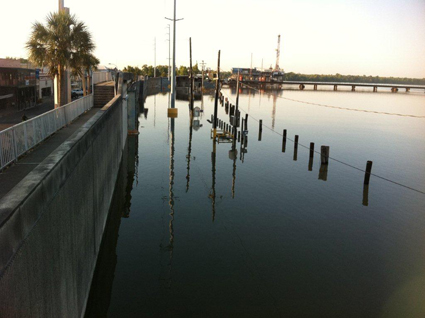
- At first glance, in the upper photo, you might think nothing was amiss on the Morgan City waterfront. However, those pilings you see in the water are on the water side of a dock. The signs between the pilings and the concrete seawall make it clear that the dock, usually dry, is severely below water.
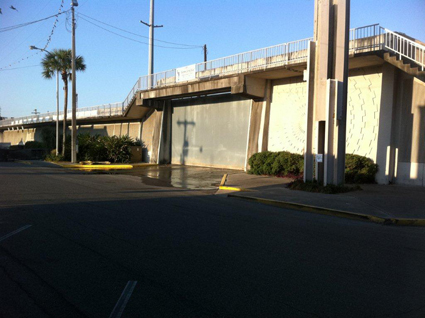
- In this photo, you can see the flood gate through which people and vehicles can normally walk through to the dock. Now things are battened down tight against the rising river.

- On the opposite shore of the Atchafalaya River, Lighthouse Park, dominated by the original lighthouse that used to guide shipping into the river, is underwater by May 19. The lighthouse is flanked by a flood gate in the city seawall. “This is the place where we would sit to watch the fireworks for Morgan City’s Shrimp and Petroleum Festival every Labor Day weekend,” says Callais.
- Below, the fishing pier on the same side, in the community of Berwick, across from Morgan City, is inundated.
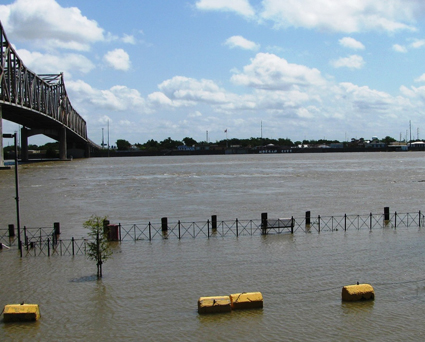
May 20:
An update from Larry Callais about the attempt to stop the backwater risk, which was a problem during the 1973 flood:
The Bayou Chene project to stop “backwater” flooding in Amelia, Morgan City, and Stephensville is completed. However, one of the “sheet piles” that was used to create the dam failed and is being replaced this morning with one that can be driven deeper into the bed of the river. This project was accomplished by sinking a large barge in the middle of the channel perpendicular to both banks and then driving sheet pile from bank to bank reinforcing both sides at the bottom with large rocks and sand bags.
This project, which under normal circumstances would have taken six weeks, has been accomplished in just over eight days with round-the-clock work and the contributions of many skilled individuals … The project is having an effect because at the present the water on the retained side is at least 1.5 feet higher than the other side.
This project is being used to stop the backwater flow and have it go off into the marshlands on both sides of the river, in turn diffusing the higher flow right down the Bayou and then into Lake Palourde and the surrounding areas.
An update from Larry Callais about the attempt to stop the backwater risk, which was a problem during the 1973 flood:
The Bayou Chene project to stop “backwater” flooding in Amelia, Morgan City, and Stephensville is completed. However, one of the “sheet piles” that was used to create the dam failed and is being replaced this morning with one that can be driven deeper into the bed of the river. This project was accomplished by sinking a large barge in the middle of the channel perpendicular to both banks and then driving sheet pile from bank to bank reinforcing both sides at the bottom with large rocks and sand bags.
This project, which under normal circumstances would have taken six weeks, has been accomplished in just over eight days with round-the-clock work and the contributions of many skilled individuals … The project is having an effect because at the present the water on the retained side is at least 1.5 feet higher than the other side.
This project is being used to stop the backwater flow and have it go off into the marshlands on both sides of the river, in turn diffusing the higher flow right down the Bayou and then into Lake Palourde and the surrounding areas.
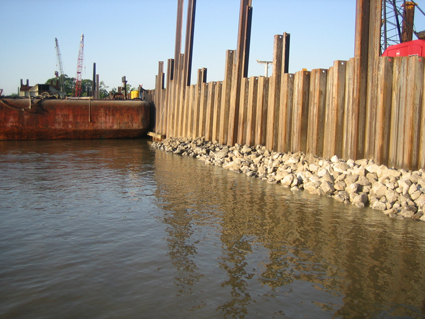
Massive steel sheets, stone, and a lot of labor, all on a foundation of a huge barge, helped to dam the Bayou Chene to prevent backwater issues for area residents.
During the course of the flooding, this project has had excellent success because the marshlands and much of the surrounding territory are drier than usual, according to Callais. He explains that the Bayou Chene project has driven not only alligators and mammals into populated areas, but also water moccasins. Residents must take care to avoid the highly poisonous snakes.
The special dam will cause moments of anxiety during the crisis, as failures of some sections need to be repaired, and strengthening attempted.
During the course of the flooding, this project has had excellent success because the marshlands and much of the surrounding territory are drier than usual, according to Callais. He explains that the Bayou Chene project has driven not only alligators and mammals into populated areas, but also water moccasins. Residents must take care to avoid the highly poisonous snakes.
The special dam will cause moments of anxiety during the crisis, as failures of some sections need to be repaired, and strengthening attempted.
May 23:
A few days later, the water level behind the dam has continued to rise. But it has kept that water from flowing into Lake Palourde, which would have hit three communities in the Morgan City environs.
Callais reports that the Atchafalaya has risen to over 9 feet and that it is projected to hit nearly 11 feet by May 28.
A few days later, the water level behind the dam has continued to rise. But it has kept that water from flowing into Lake Palourde, which would have hit three communities in the Morgan City environs.
Callais reports that the Atchafalaya has risen to over 9 feet and that it is projected to hit nearly 11 feet by May 28.
May 26:
“Things continue to look a bit better for us along the Atchafalaya River,” emails Callais. “But we are definitely not out of the woods.”
The river is just over 10 feet now, six feet over flood level, and the forecast is for 11 feet by Memorial Day.
“The Corp of Engineers closed one of the 17 bays on the Morganza Spillway facility,” Callais continues in his email. “Original plans were to open 50%, or 60 bays. Then they decided to open up to 25%, or 31 bays. Then they ended up opening 17 bays and now have actually closed one of those. That is good news and gives a bit of indication that what has been done to this point to alleviate the pressure on the levee in Baton Rouge and New Orleans is working.”
Adds Callais: “Our prayer is that this closing is a trend.”
In a sign of the times, the Mayor’s Office, in its regular statement, issues a reminder: “Stay tuned to your local radio and television stations and The Daily Review for updates as well as www.cityofmc.com and ONLY the CITY OF MORGAN CITY and other GOVERNMENT SPONSORED Facebook pages. Rumors and ‘I heard’ are most often not accurate information.”
May 27:
Things are looking brighter, but that is a relative term.
Callais’ main office is half a mile from the river, and he’s been able to watch the rising river daily from his bank’s boardroom.
Some customers haven’t been so fortunate. Fuel companies and others had to lock things down and secure their facilities for flooding. Leakage of toxins isn’t an issue, Callais says, because the yards have long been designed with the risk of a flood in mind. But there will be cleanup and inevitable damage to be fixed, when the waters recede.
There are signs on the waterfront of how high the water has risen.
Things are looking brighter, but that is a relative term.
Callais’ main office is half a mile from the river, and he’s been able to watch the rising river daily from his bank’s boardroom.
Some customers haven’t been so fortunate. Fuel companies and others had to lock things down and secure their facilities for flooding. Leakage of toxins isn’t an issue, Callais says, because the yards have long been designed with the risk of a flood in mind. But there will be cleanup and inevitable damage to be fixed, when the waters recede.
There are signs on the waterfront of how high the water has risen.
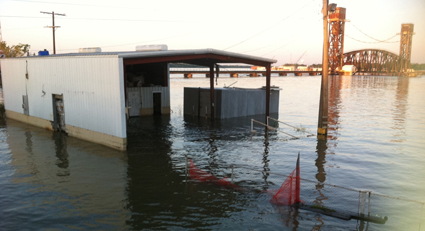
- This icehouse, where Morgan City’s fishing fleet buys the means to preserve its catch, is normally seven steps from ground level. The river has already covered more than a foot above the building’s floor, and there’s at least another foot of flood expected.
May 31:
Callais reports that the 11-foot crest most recently forecast was, blessedly, wrong. The river stands at 10.19 feet and is expected to crest at 10.4 feet.
Callais reports that the 11-foot crest most recently forecast was, blessedly, wrong. The river stands at 10.19 feet and is expected to crest at 10.4 feet.
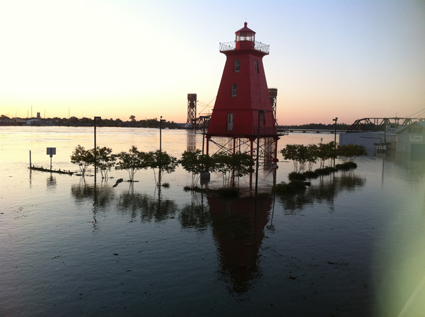
- Lighthouse Park’s trees look more like bushes, the river level has risen so far.
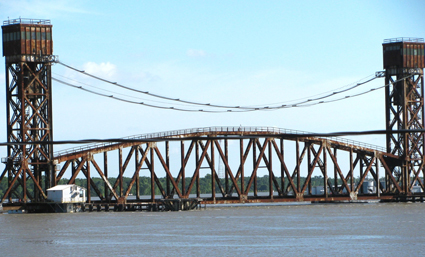
- The swollen Atchafalaya has nearly approached the bottom of this railroad bridge that normally spans it eight feet above the water’s surface.
June 1:
In his final email, Larry Callais strikes an upbeat note:
Here is the information as of 6:00 AM today:
• Flood stage is 4.0 feet
• Current level is 10.2 feet and the river has crested 0.8 feet below the expected level.
• This level should remain through 6/3 with a slight drop to 10 feet by 6/6.
• The Bayou Chene project is still holding and making a difference with back water.
• River should remain above the banks for a while yet.
Thanks to all for the prayers and thoughts. All of us in the Morgan City area are truly appreciative of your concern.
Callais notes that the maritime businesses on the waterfront will be back to it as soon as possible. “They’ve been through this kind of thing on more than one occasion,” he points out.
Dredging the river for navigation is necessary under normal conditions and is expected to be needed as things get back to normal. Floods like this carry not only the water, but the silt of “Big Muddy”—the Mississippi—and that is going to have to be taken care of to preserve the channel.
In his final email, Larry Callais strikes an upbeat note:
Here is the information as of 6:00 AM today:
• Flood stage is 4.0 feet
• Current level is 10.2 feet and the river has crested 0.8 feet below the expected level.
• This level should remain through 6/3 with a slight drop to 10 feet by 6/6.
• The Bayou Chene project is still holding and making a difference with back water.
• River should remain above the banks for a while yet.
Thanks to all for the prayers and thoughts. All of us in the Morgan City area are truly appreciative of your concern.
Callais notes that the maritime businesses on the waterfront will be back to it as soon as possible. “They’ve been through this kind of thing on more than one occasion,” he points out.
Dredging the river for navigation is necessary under normal conditions and is expected to be needed as things get back to normal. Floods like this carry not only the water, but the silt of “Big Muddy”—the Mississippi—and that is going to have to be taken care of to preserve the channel.
Bank contingency plans
M C Bank and other financial institutions in the area more typically worry about hurricanes, rather than such massive flooding risk. But the bank had contingency plans in place that it prepared for in specific and told the public about in general.
“We’ve braved nature before, and we will once again,” Callais wrote on the bank’s website to its customers. “If one or more of our locations is affected, be assured we’re working at higher-ground locations to serve you.”
The bank set up a second main office, effectively, in its Lafayette, La., branch, 72 miles northwest of Morgan City. Callais explained that while the bank maintains a generator at its headquarters, that’s of necessity on the ground floor, and wouldn’t have functioned had the floodwaters invaded city streets.
Additional backstops were also in place.
Shortly after 2005’s Hurricane Katrina, Fiserv, the bank’s core processor, assisted its area client banks to set up “buddy banks” among those institutions. Each bank in the circle maintains a port that a bank buddy can use to hook up temporary operating facilities at that bank to Fiserv. This permits continuing operations from the remote location. M C Bank maintains such a port should it be called on by a “buddy.” Callais notes that this year his bank test-hosted a buddy and last year a buddy let his bank conduct a test. All employees who would have to relocate to the backup facility know their assignments in advance.
There’s also unplanned help that can be found. Callais notes that his bank is the only financial institution in town that’s headquartered there. When another Louisiana bank out of harm’s way heard about the spillway release, it offered M C Bank the entire upstairs space in one of its buildings.
M C Bank and other financial institutions in the area more typically worry about hurricanes, rather than such massive flooding risk. But the bank had contingency plans in place that it prepared for in specific and told the public about in general.
“We’ve braved nature before, and we will once again,” Callais wrote on the bank’s website to its customers. “If one or more of our locations is affected, be assured we’re working at higher-ground locations to serve you.”
The bank set up a second main office, effectively, in its Lafayette, La., branch, 72 miles northwest of Morgan City. Callais explained that while the bank maintains a generator at its headquarters, that’s of necessity on the ground floor, and wouldn’t have functioned had the floodwaters invaded city streets.
Additional backstops were also in place.
Shortly after 2005’s Hurricane Katrina, Fiserv, the bank’s core processor, assisted its area client banks to set up “buddy banks” among those institutions. Each bank in the circle maintains a port that a bank buddy can use to hook up temporary operating facilities at that bank to Fiserv. This permits continuing operations from the remote location. M C Bank maintains such a port should it be called on by a “buddy.” Callais notes that this year his bank test-hosted a buddy and last year a buddy let his bank conduct a test. All employees who would have to relocate to the backup facility know their assignments in advance.
There’s also unplanned help that can be found. Callais notes that his bank is the only financial institution in town that’s headquartered there. When another Louisiana bank out of harm’s way heard about the spillway release, it offered M C Bank the entire upstairs space in one of its buildings.
Tagged under Risk Management, Community Banking,
Related items
- OCC Seeks Input on Challenges Facing Community Banks in Digitalization
- OCC to Remove Dedicated Supervision for Community Banks
- Trump Policies Setting Up Resurgence of Swiss Bank Accounts
- Lawmakers File Resolution to Overturn OCC’s Bank Merger Rule
- JPMorgan Chase Tops Estimates but CEO Cautions Investors













